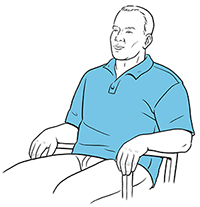When you have lung problems, you may find it harder to take deep breaths. Learning to use controlled breathing can help you get more air into and out of your lungs. This will help you with shortness of breath. Belly breathing (diaphragmatic breathing) helps you breathe with your diaphragm. The diaphragm is a large muscle that plays an important part in breathing. It is located below your lungs. It separates your chest from your belly (abdomen).
Home care
Follow these steps to use controlled breathing:
-
Sit in a comfortable chair. Or lie on your back with a pillow under your head with your knees bent.
-
Relax the muscles in your neck and shoulders.
-
Place 1 hand on your stomach. Place the other hand on your upper chest.
-
Breathe in (inhale) slowly through your nose as deeply as you can for 2 seconds. As you inhale, your stomach should move out against your hand. Your chest should stay still.
-
Breathe out (exhale) slowly with your lips together, like you are blowing out a candle (called pursed lips). You should exhale 2 to 4 times longer than you inhale. You should feel your stomach muscles move in.
-
Repeat the above steps until you feel relaxed. Or until you no longer feel short of breath.
Follow-up care
Follow up with your health care provider as advised.
When to contact your doctor
Contact your provider right away if:
-
You have shortness of breath that is not eased by controlled breathing exercises or by your medicine.
-
You are wheezing or coughing.
-
You have more mucus.
-
You cough up yellow, green, bloody, or smelly mucus.
-
You have chills.
-
You have a fever of 100.4°F (38°C) or higher, or as directed by your health care provider.
-
You have tightness in your chest that does not go away with your normal medicines.
-
You have an irregular heartbeat.
-
You have swollen ankles.
-
You have trouble doing your normal activities.




